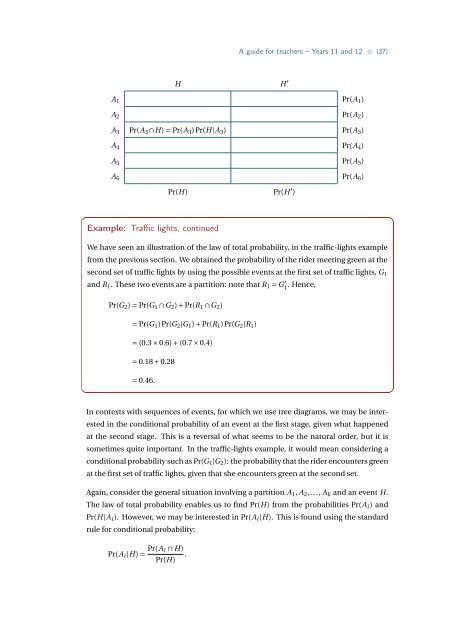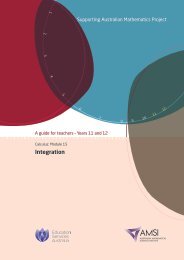Probability - the Australian Mathematical Sciences Institute
Probability - the Australian Mathematical Sciences Institute
Probability - the Australian Mathematical Sciences Institute
- No tags were found...
You also want an ePaper? Increase the reach of your titles
YUMPU automatically turns print PDFs into web optimized ePapers that Google loves.
A guide for teachers – Years 11 and 12 • {37}H H ′A 1 Pr(A 1 )A 2 Pr(A 2 )A 3 Pr(A 3 ∩H) = Pr(A 3 )Pr(H|A 3 ) Pr(A 3 )A 4 Pr(A 4 )A 5 Pr(A 5 )A 6 Pr(A 6 )Pr(H) Pr(H ′ )Example: Traffic lights, continuedWe have seen an illustration of <strong>the</strong> law of total probability, in <strong>the</strong> traffic-lights examplefrom <strong>the</strong> previous section. We obtained <strong>the</strong> probability of <strong>the</strong> rider meeting green at <strong>the</strong>second set of traffic lights by using <strong>the</strong> possible events at <strong>the</strong> first set of traffic lights, G 1and R 1 . These two events are a partition: note that R 1 = G1 ′ . Hence,Pr(G 2 ) = Pr(G 1 ∩G 2 ) + Pr(R 1 ∩G 2 )= Pr(G 1 )Pr(G 2 |G 1 ) + Pr(R 1 )Pr(G 2 |R 1 )= (0.3 × 0.6) + (0.7 × 0.4)= 0.18 + 0.28= 0.46.In contexts with sequences of events, for which we use tree diagrams, we may be interestedin <strong>the</strong> conditional probability of an event at <strong>the</strong> first stage, given what happenedat <strong>the</strong> second stage. This is a reversal of what seems to be <strong>the</strong> natural order, but it issometimes quite important. In <strong>the</strong> traffic-lights example, it would mean considering aconditional probability such as Pr(G 1 |G 2 ): <strong>the</strong> probability that <strong>the</strong> rider encounters greenat <strong>the</strong> first set of traffic lights, given that she encounters green at <strong>the</strong> second set.Again, consider <strong>the</strong> general situation involving a partition A 1 , A 2 ,..., A k and an event H.The law of total probability enables us to find Pr(H) from <strong>the</strong> probabilities Pr(A i ) andPr(H|A i ). However, we may be interested in Pr(A i |H). This is found using <strong>the</strong> standardrule for conditional probability:Pr(A i |H) = Pr(A i ∩ H).Pr(H)
















